Routine use of clinical management guidelines in Australian general practice
Mark F. Harris A C , Jane Lloyd A , Yordanka Krastev A , Mahnaz Fanaian A , Gawaine Powell Davies A , Nick Zwar B and Siaw-Teng Liaw BA Centre for Primary Health Care and Equity, 3rd Floor AGSM Building, University of New South Wales, NSW 2052, Australia.
B School of Public Health and Community Medicine, University of New South Wales, NSW 2052, Australia.
C Corresponding author. Email: m.f.harris@unsw.edu.au
Australian Journal of Primary Health 20(1) 41-46 https://doi.org/10.1071/PY12078
Submitted: 12 June 2012 Accepted: 19 September 2012 Published: 18 October 2012
Abstract
Significant gaps remain between recommendations of evidence-based guidelines and primary health care practice in Australia. This paper aims to evaluate factors associated with the use of guidelines reported by Australian GPs. Secondary analysis was performed on a survey of primary care practitioners which was conducted by the Commonwealth Fund in 2009: 1016 general practitioners responded in Australia (response rate 52%). Two-thirds of Australian GPs reported that they routinely used evidence-based treatment guidelines for the management of four conditions: diabetes, depression, asthma or chronic obstructive pulmonary disease and hypertension – a higher proportion than in most other countries. Having non-medical staff educating patients about self-management, and a system of GP reminders to provide patients with test results or guideline-based intervention or screening tests, were associated with a higher probability of guidelines use. Older GP age was associated with lower probability of guideline usage. The negative association with age of the doctor may reflect a tendency to rely on experience rather than evidence-based guidelines. The association with greater use of reminders and self-management is consistent with the chronic illness model.
Introduction
Internationally, the adoption of an evidence-based approach to clinical practice has been accompanied by an increase in the development of evidence-based guidelines over the past two decades. The use of guidelines is seen as an effective vehicle for ensuring evidence-based care (Prior et al. 2008; Lugtenberg et al. 2009). Best practice methods for developing guidelines have been agreed upon and are routinely practiced (National Health and Medical Research Council 1999). However, the uptake of guideline recommendations into routine practice is proving difficult. For example, in Australia evidence-based guidelines for the management of common chronic conditions such as diabetes, asthma, chronic obstructive pulmonary disease (COPD), hypertension and depression are readily available to GPs (Ellis and Royal Australian and New Zealand College of Psychiatrists Clinical Practice Guidelines Team for Depression 2004; National Health and Medical Research Council 2005; Abramson et al. 2006; National Asthma Council Australia 2006; National Vascular Disease Prevention Alliance 2009; beyondblue 2010; Abramson et al. 2011). These guidelines are well regarded by the general practice community and have been widely disseminated. However, in keeping with international trends, gaps remain between the recommendations in these guidelines and current practice in Australian primary health care (Heeley et al. 2010).
Barriers to taking up and using guidelines may vary with the guidelines, practitioners and organisations involved. Therefore analysing the particular barriers to the implementation of different guidelines is an important first step in improving quality of care (Cabana et al. 1999; Lugtenberg et al. 2009; Baker et al. 2010).
Guideline characteristics – The content of guidelines can influence guideline uptake. Less complex guidelines, which require less change in practice organisation, have been found to be more likely to be adhered to by clinicians (Francke et al. 2008). Guideline recommendations which are less dissonant with existing practice are more likely to be followed (Rashidian et al. 2008). Desirable attributes of guidelines include clinical applicability, clinical flexibility and clarity (Grimshaw et al. 2004).
Organisational characteristics – Overall, the practice culture and its openness to change have an impact on guideline use (Harris et al. 2005). Barriers include a lack of supportive organisational infrastructure such as information management systems, referral options and specific funding to support assessment (Baker et al. 2010). Elements of organisational culture such as leadership support, inter-professional collaboration and shared beliefs about the utility of guidelines also promote adherence to guideline recommendations (Dodek et al. 2010). These are consistent with the chronic illness model which identifies systems needed to underpin effective patient-centred care for those with chronic disease in primary care (Wagner et al. 1996).
Practitioner and patient characteristics – Common reasons cited among GPs for failing to offer interventions to patients at high risk or with already developed chronic diseases include: clinical uncertainty, patient expectations, competing demands for GPs and patients, and time constraints (Abramson et al. 2006; Ayres and Griffith 2007).
Less is known about the impact that personal characteristics of providers, such as their age or proximity to retirement, have on guideline uptake and use. In addition, relatively little is known about the impact of non-medical providers in chronic disease management guideline use in Australian general practice. However, their importance in chronic disease care has been acknowledged in the recent health reform documents such as the Primary Health Care Strategy (Department of Health and Ageing 2010) and financial incentives are being trialled to promote evidence-based team care in Australian general practice (National Health and Hospitals Network 2010).
This study examines data from the 2009 International Survey of General Practitioners conducted by the Commonwealth Fund (Commonwealth Fund 2009). The Survey was run in 11 countries, including Australia, Canada, France, Germany, Italy, Netherlands, New Zealand, Norway, Sweden, UK and USA. It complements other surveys conducted by the Commonwealth Fund to compare the characteristics and performance of health systems across countries in order to stimulate innovative policies and practices. The aim of this research was to compare the self-reported adoption of guidelines by Australian GPs in comparison with their international counterparts and to evaluate practice and practitioner factors associated with the use of guidelines reported by Australian GPs.
Methods
Design
This was a secondary analysis of a cross-sectional survey of primary care practitioners.
Recruitment
The Australian sample was randomly drawn from a national list stratified by state. Oversamples were drawn to ensure adequate sampling from major cities, inner regional, outer regional and remote/very remote areas; 2025 doctors were phoned and the 1950 were contacted. After those who were ineligible and refusals were eliminated, 1620 surveys were mailed. In total, 1016 GPs completed the survey in Australia (a response rate of 52%). The response rate varied quite dramatically between countries, with an extremely poor response rate of 7% in France (Table 1).
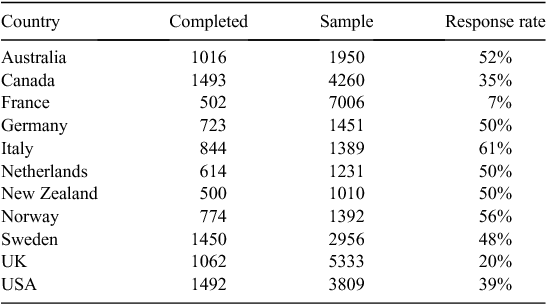
|
Potential respondents were recruited and screened by phone (using a computer-assisted telephone interview) and asked to return the completed survey by mail. As part of the recruitment process, interviewers called GPs and confirmed that they were a GP, spending at least 50% of their time in direct patient care. Reminder telephone calls were made to non-responders after ~2 weeks. Respondents in Australia and in New Zealand were offered an incentive of AU$50.
Data collection
The survey was conducted in Australia and New Zealand from February to May, 2009.
Survey instrument
The survey overall examined how primary care doctors perceived the quality of care in their respective country and what factors they viewed as impeding or supporting high-quality, efficient, patient-centred care, including:
-
use of multidisciplinary teams and impact on professional boundaries and roles;
-
use of electronic medical records;
-
quality improvement and professional career competency activities;
-
clinical information capacity; and
-
experience with payment incentives to improve quality, productivity and care coordination.
The questionnaire was four pages long taking ~20 min to complete (Commonwealth Fund 2009). With the exception of a few country-specific questions the surveys for all countries were identical. The questionnaire was translated into the official language for each country. General practitioners were asked whether their practice routinely used written evidence-based treatment guidelines to treat diabetes, depression, asthma or COPD, hypertension and attention-deficit hyperactivity disorder (ADHD). We conducted a secondary analysis of the data and focussed only on GPs’ responses to their reported use in the four chronic conditions: diabetes, depression, asthma or COPD and hypertension. They were also asked whether their practice included any other health care providers (e.g. nurses, nurse practitioners, physician assistants, medical assistants or pharmacists) who share responsibility for managing patient care. In particular they were asked if any of these other staff helped manage patient care by:
-
calling patients to check on medications, symptoms, or help coordinate care in-between visits;
-
executing standing orders for medication refills, ordering tests or delivering routine preventive services;
-
educating patients about managing their own care; and
-
counselling patients on exercise, nutrition and how to stay healthy.
Data analysis
An ‘a priori’ framework and set of hypotheses guided the analysis (Fig. 1). These assumed that guideline use would be negatively associated with GP age and experience and positively associated with enabling factors in the practice based on elements of the chronic illness model, including multidisciplinary team work, support for self-management, use of information systems to improve care and performance incentives for improved quality of care (Wagner et al. 1996). All data analyses were performed using SPSS (SPSS Inc., Chicago, IL, USA). Records with missing values for either the outcome or any of the predictors were omitted from the logistic regression analysis.
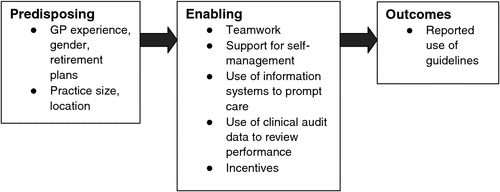
|
Ethics
Univeristy of NSW Human Research Ethics Advisory Panel determined that ethics approval was not required for this secondary analysis of non-identifiable data.
Results
Variation in the use of guidelines between Australian GPs and their international counterparts
Analysis of the 2009 International Survey of General Practitioners revealed variations in the use of clinical practice guidelines by Australian GPs compared with their international counterparts. While primary health care providers in the UK were more likely to report using written guidelines than Australian GPs, Australia performed well compared with the international average. Australian GPs were more likely to report using written evidence-based treatment guidelines (67%) for all four conditions (diabetes, depression, asthma and hypertension) compared with their international counterparts (45%) (Table 2 and Fig. 2).
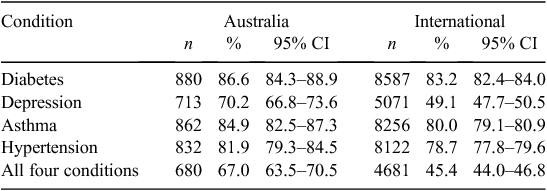
|
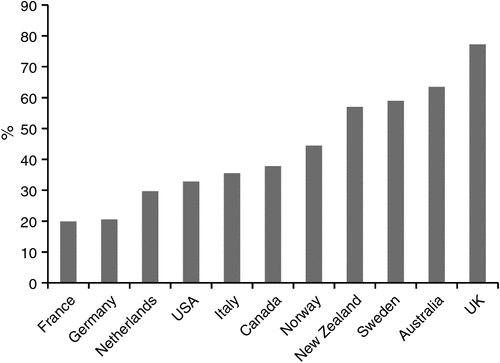
|
Variation in the use of guidelines according to different conditions
However, there was some variability between different conditions in the proportion of Australian GPs reporting that their practice routinely used written evidence-based treatment guidelines. Australian GPs reported use of guidelines for patients with diabetes (87%, 95% CI 84.9–89.6), asthma (85%, 95% CI 82.8–87.2) and hypertension (82%, 95% CI 79.6–84.4) was higher than their reported use of depression guidelines (70%, 95% CI 67.2–72.8). This is consistent with the international picture, where the use of depression guidelines was far lower at 49% (compared with the other chronic conditions of diabetes (83%) asthma (80%) and hypertension (79%)). These findings confirm that there are variations in the uptake of guidelines depending on the guideline itself and across countries.
Association between guideline use and practice and practitioner characteristics
Univariate analysis revealed that there were associations between Australian GPs’ reported guideline use and the age of the GP, their proximity to retirement and the location of their practice. GPs who were older, practised in rural areas or who planned to retire in the next 5 years were less likely to report routine use of all four guidelines. There were no associations with the gender of the GP, practice size or hours worked per week (Table 3).
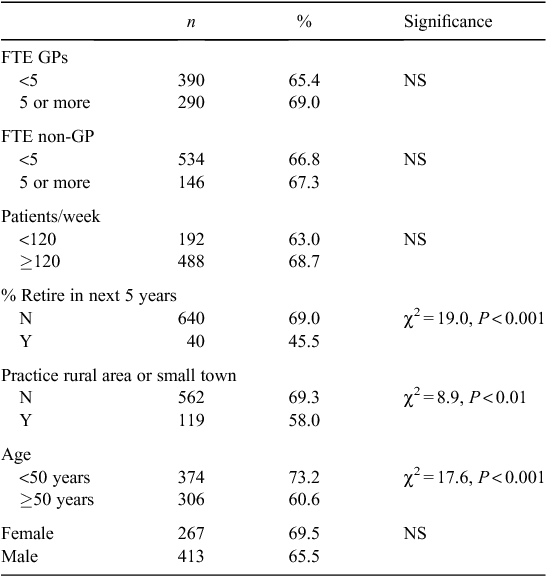
|
Organisation of care which may underpin guideline use
There were associations between reported guideline use and practice organisation (Table 3). Australian GPs were significantly more likely to report routine use of guidelines if:
-
non-doctor health professionals routinely called patients to check progress between visits (88%), counselled patients on exercise and nutrition (76%), and educated patients about self management (74%);
-
their practice’s overall electronic functioning was high (69%) and they used computers to generate reminders for preventive care (73%) or provided reminders for guideline-based intervention or screening (79%); and
-
performance was annually reviewed against targets (72%).
There were no associations with audit of clinical outcomes, patient surveys or financial incentives (Table 4).
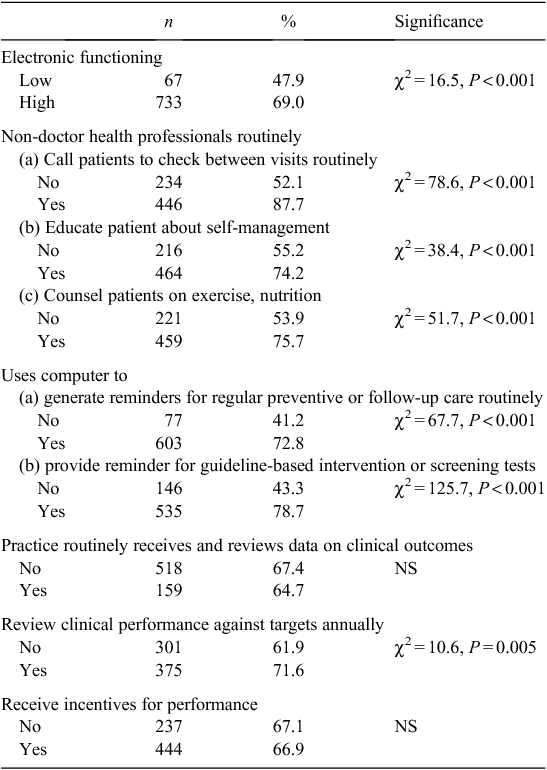
|
Multivariate analysis
In multivariate analysis, reported guideline use was positively associated with non-GP staff phoning to check on patients between visits, non-GP staff counselling patients on lifestyle changes and GPs receiving reminders for guideline-based interventions or screening. However, after adjusting for covariates, those whose practices provided self-management education by non-GPs were less likely to report using the guidelines. The multivariate analysis also revealed that GPs who were over 50 were less likely to report routine guideline use (Table 5).
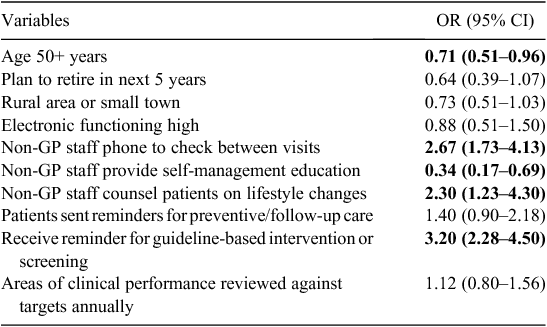
|
Discussion
Most Australian GPs reported using evidence-based guidelines for diabetes, depression, asthma or COPD and hypertension. This compared favourably with other countries participating in the survey. However, 33% of GPs were still not using guidelines for all four conditions which is consistent with other research on quality of care in Australian clinical practice (Runciman et al. 2012). Guideline use for patients with depression was less frequent than for the other conditions. This may be related to several factors, including the guideline recommendations (which advocate the use of non-drug psychological interventions, especially in young people) and thus may be difficult to implement in practice, as well as the implementation process for the guidelines. In Australia, the National Health and Medical Research Council (NHMRC)-endorsed depression guidelines have been disseminated to GPs only for children and adolescents by bodies such as beyondblue (beyondblue 2010).
Older GPs reported using guidelines somewhat less frequently. This may be because they were already familiar with the recommendations or because they were more likely to rely on experience than the guidelines. The latter has been observed in other studies of guideline implementation (Saillour-Glenisson and Michel 2003).
In the final logistic regression model, GPs were more likely to report using all four guidelines in practices where non-GP staff followed-up patients between visits and provided lifestyle counselling. Sixty-five percent of GPs reported that non-GP staff provided at least one of the following activities:
-
phoning to check progress between visits;
-
counselling patients on exercise and nutrition; and
-
educating patients about self-management.
These factors were highly correlated. If non-doctor health professionals conducted one of the above-mentioned tasks they were likely to do the other two tasks as well. Although GPs from practices where non-GP-provided self-management education were more likely to use the guidelines, this association was reversed when there was adjustment for other variables. It is unclear why this was so, especially given the support in many guidelines for active involvement and education of patients (National Health and Medical Research Council 2005; Abramson et al. 2011). The likely explanation is that this was due to the strong correlation between this variable and other variables strongly associated with reported guideline use. Further prospective research is needed to tease this out.
Practice care systems were associated with guideline use – notably involving other non-GP staff in calling patients between visits and counselling (team work) and using decision support systems (reminders for evidence-based care). Guidelines use in this study was more frequent in practices where GPs and/or patients reported receiving reminders for guideline-based intervention or screening. This is consistent with other research on guideline implementation (Prior et al. 2008). However, reported guideline use was not associated with receiving incentives or using data for quality assurance (reviewing outcomes and performance annually). This is despite Medicare incentives for quality delivering care for diabetes and asthma (Prior et al. 2008). This suggests that incentives for quality improvement in Australia may not be, as yet, sufficiently developed (relative to fee for service) to support more effective preventive care, as envisaged by the chronic illness model (Wagner et al. 1996).
The major limitation of this study is that it was based on self-report by GPs. Although this is likely to overestimate guideline use, the findings are broadly consistent with other research. However, it is important not to infer causality from the associations in this cross-sectional study, as for example, it is possible that some associations may be coincidental or due to some third factor. Further research is needed to prospectively examine the influence of changes to these organisational factors on guideline use.
Conclusion
Australian GPs are relatively advanced in their adoption and use of evidence-based guidelines compared with their international counterparts. However, more support is required for GPs to use guidelines for particular conditions such as depression. This study confirms that the practitioner and practice characteristics and the care systems used by organisations play an important role in supporting the use of evidence-based guidelines. In addition to the proliferation of research on the need for interventions to facilitate the implementation of guidelines, further work is required to identify which providers and practices are going to need extra support to provide care in accordance with evidence-based guidelines.
Together with other research, this study confirms the importance of multidisciplinary team approaches and the use of information systems in supporting better care. Medicare Locals and other organisations concerned with improving quality in general practice have a key role in supporting both of these at the practice level. This support should be tailored to the individual characteristics of the practice and practitioner rather than a ‘one size fits all’ approach. Performance-based incentives are relatively weak within Australian general practice and require more development if they are to have a more significant impact on evidence-based practice.
Conflicts of interest
None declared.
Acknowledgements
This analysis was funded by a grant from the Department of Health and Ageing on behalf of the Australian Commission on Safety and Quality in Health Care. The authors thank Nicola Dunbar for her support with the project. The Commonwealth Fund’s ‘2009 International Survey of Primary Care Physicians in Eleven Countries’ received core funding from the Commonwealth Fund with funding of a full (expanded) Australian sample for the survey by the Australian Commission on Safety and Quality in Health Care.
References
Abramson MJ, Crockett AJ, Frith PA, McDonald CF (2006) COPDX: an update of guidelines for the management of chronic obstructive pulmonary disease with a review of recent evidence. The Medical Journal of Australia 184, 342–345.Abramson M, Brown J, Crockett AJ, Dabscheck E, Frith PA, Glasgow N, Jenkins S, McDonald CF, McKenzie DK, Wook-Bker R, Young I (2011) The COPD-X Plan: Australian and New Zealand Guidelines for the management of Chronic Obstructive Pulmonary Disease. (The Australian Lung Foundation: Brisbane) Available at www.copdx.org.au [Verified 2 October 2012]
Ayres CG, Griffith HM (2007) Perceived barriers to and facilitators of the implementation of priority clinical preventive services guidelines. The American Journal of Managed Care 13, 150–155.
Baker R, Camosso-Stefinovic J, Gillies C, Shaw EJ, Cheater F, Flottorp S, Robertson N (2010) Tailored interventions to overcome identified barriers to change: effects on professional practice and health care outcomes. Cochrane Database of Systematic Reviews CD005470
beyondblue (2010) Clinical practice guidelines: depression in adolescents and young adults. beyondblue: the national depression initiative, Melbourne.
Cabana MD, Rand CS, Powe NR, Wu AW, Wilson MH, Abboud PC, Rubin HR (1999) Why don’t physicians follow clinical practice guidelines? A framework for improvement. Journal of the American Medical Association 282, 1458–1465.
| Why don’t physicians follow clinical practice guidelines? A framework for improvement.Crossref | GoogleScholarGoogle Scholar | 1:STN:280:DC%2BD3c%2FgsVSqtw%3D%3D&md5=be1a2281e9fadf445b4f52c4d3c19146CAS |
Commonwealth Fund (2009) International survey of primary care doctors. (Commonwealth Fund: New York) Available at http://www.commonwealthfund.org/~/media/Files/News/News%20Releases/2009/Nov/J35061_PCP%20SURVEY_02_17_09_FINAL.pdf [Verified August 2012]
Department of Health and Ageing (2010) Building a 21st century primary health care system: Australia’s first national primary health care strategy. Commonwealth of Australia, Canberra.
Dodek P, Cahill N, Heyland D (2010) The relationship between organisational culture and implementation of clinical practice guidelines: a narrative review. Journal of Parenteral and Enteral Nutrition 34, 669–674.
| The relationship between organisational culture and implementation of clinical practice guidelines: a narrative review.Crossref | GoogleScholarGoogle Scholar |
Ellis P, Royal Australian and New Zealand College of Psychiatrists Clinical Practice Guidelines Team for Depression (2004) Australian and New Zealand clinical practice guidelines for the treatment of depression. The Australian and New Zealand Journal of Psychiatry 38, 389–407.
Francke AL, Smit MC, de Veer AJE, Mistiaen P (2008) Factors influencing the implementation of clinical guidelines for health care professionals: a systematic meta-review. BMC Medical Informatics and Decision Making 8, 38
| Factors influencing the implementation of clinical guidelines for health care professionals: a systematic meta-review.Crossref | GoogleScholarGoogle Scholar |
Grimshaw JM Thomas RE MacLennan G Fraser C Ramsay CR Vale L Whitty P Eccles MP Matowe L Shirran L Wensing M Dijkstra R Donaldson C 2004 Effectiveness and efficiency of guideline dissemination and implementation strategies. Health Technology Assessment 8 6
Harris MF, Hobbs C, Powell Davies G, Simpson S, Bernard D, Stubbs A (2005) Implementation of a SNAP intervention in two divisions of general practice: a feasibility study. The Medical Journal of Australia 183, S54–S58.
Heeley EL, Peiris DP, Patel AA, Cass A, Weekes A, Morgan C, Anderson CS, Chalmers JP (2010) Cardiovascular risk perception and evidence–practice gaps in Australian general practice (the AusHEART study). The Medical Journal of Australia 192, 254–259.
Lugtenberg M, Burgers JS, Westert GP (2009) Effects of evidence-based clinical practice guidelines on quality of care: a systematic review. Quality & Safety in Health Care 18, 385–392.
| Effects of evidence-based clinical practice guidelines on quality of care: a systematic review.Crossref | GoogleScholarGoogle Scholar | 1:STN:280:DC%2BD1Mnns1yjuw%3D%3D&md5=84c1752fbe056ee24e07c6cdde70bb3dCAS |
National Asthma Council Australia (2006) Asthma management handbook. (National Asthma Council of Australia: Melbourne)
National Health and Hospitals Network (2010) Coordinated care for patients with diabetes. Available at www.yourhealth.gov.au [Verified 1 October 2012]
National Health and Medical Research Council (1999) A guide to the development, evaluation and implementation of clinical practice guidelines. (National Health and Medical Research Council: Canberra)
National Health and Medical Research Council (2005) National evidence based guidelines for the management of type 2 diabetes mellitus: primary prevention, case detection and diagnosis. (National Health and Medical Research Council: Canberra)
National Vascular Disease Prevention Alliance (2009) Guidelines for the assessment of absolute cardiovascular disease risk. (National Heart Foundation of Australia: Melbourne)
Prior M, Guerin M, Grimmer-Somers K (2008) The effectiveness of clinical guideline implementation strategies – a synthesis of systematic review findings. Journal of Evaluation in Clinical Practice 14, 888–897.
| The effectiveness of clinical guideline implementation strategies – a synthesis of systematic review findings.Crossref | GoogleScholarGoogle Scholar |
Rashidian A, Eccles MP, Russell I (2008) Falling on stony ground? A qualitative study of implementation of clinical guidelines’ prescribing recommendations in primary care. Health policy (Amsterdam, Netherlands) 85, 148–161.
| Falling on stony ground? A qualitative study of implementation of clinical guidelines’ prescribing recommendations in primary care.Crossref | GoogleScholarGoogle Scholar |
Runciman WB, Hunt T, Hannaford NA, Hibber PD, Westbrook JI, Coiera EW, Day RO, Hindmarsh DM, McGlynn EA, Braithwaite J (2012) Care track: assessing the appropriateness of health care delivery in Australia. The Medical Journal of Australia 197, 100–105.
| Care track: assessing the appropriateness of health care delivery in Australia.Crossref | GoogleScholarGoogle Scholar |
Saillour-Glenisson F, Michel P (2003) Individual and collective facilitators of and barriers to the use of clinical practice guidelines by physicians: a literature review. Revue d’Epidemiologie et de Sante Publique 51, 65–80.
Wagner EH, Austin BT, Von Korff M (1996) Organising care for patients with chronic illness. The Milbank Quarterly 74, 511–544.
| Organising care for patients with chronic illness.Crossref | GoogleScholarGoogle Scholar | 1:STN:280:DyaK2s%2Fps1agtA%3D%3D&md5=ad2e0917931c8da57bb2434d79e3ff8fCAS |


